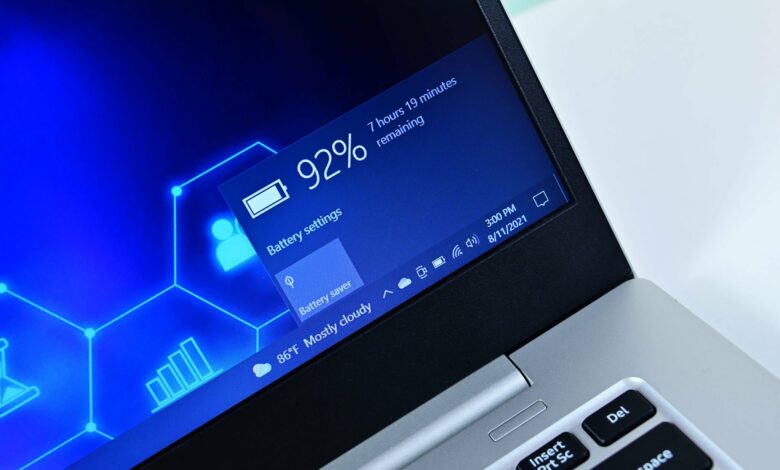How To Check Laptop Battery Health in Windows 11, Windows 10, and Mac: A Comprehensive Guide

Table of Content
How to check battery health in Windows is an essential task that every laptop user should perform regularly. A healthy battery ensures that your laptop runs smoothly and efficiently without any unexpected shutdowns. If you are a Windows 11, Windows 10, or Mac user, you can quickly check your laptop’s battery health using built-in tools. In this article, How To Check Laptop Battery Health, we will guide you through the process of checking your laptop’s battery health on these operating systems.
Windows 11, Windows 10, and Mac come with built-in tools that allow you to check your laptop’s battery health. These tools provide you with information about the battery’s current state, including its capacity, charge level, and other essential details. By regularly checking your laptop’s battery health, you can ensure that your battery is functioning correctly and identify any potential issues before they become significant problems. In the following sections, we will provide step-by-step instructions on how to check your laptop’s battery health on Windows 11, Windows 10, and Mac.
Read Also: How to Screen Record in Windows 10 and Windows 11
How To Check Laptop Battery Health
Battery health is an important aspect to consider when it comes to the longevity and performance of a laptop battery. It refers to the overall condition of the battery and its ability to hold a charge over time.
To understand battery health, you need to know the different factors that can affect it. These include the number of charge cycles, temperature, and usage patterns.
Charge cycles refer to the number of times the battery has been charged and discharged. The more charge cycles a battery goes through, the more its capacity to hold a charge decreases.
Temperature is another crucial factor that affects battery health. High temperatures can cause the battery to degrade faster, while low temperatures can affect its performance.
Usage patterns also play a role in battery health. For example, using resource-intensive applications or leaving the laptop plugged in for extended periods can put additional strain on the battery and cause it to degrade faster.
By understanding these factors, users can take steps to improve their laptop battery health and prolong its lifespan. This includes avoiding overcharging the battery, keeping the laptop in a relaxed and well-ventilated area, and adjusting power settings to reduce strain on the battery.
How To Check Laptop Battery Health in Windows 11
Windows 11 comes with several built-in tools that can help you check your laptop’s battery health. In this section, we will discuss three methods to check your laptop’s battery health on Windows 11.
Using Windows Settings
Windows Settings is a built-in utility that allows users to customize various settings on their Windows 11 systems. To check your laptop’s battery health using Windows Settings, follow these steps:
- Click on the Start menu and select Settings.
- Click on System.
- Click on Battery.
- Under the Battery Health section, you can view your battery’s current status, including its capacity and estimated lifespan.
Using Command Prompt
Command Prompt is a command-line utility that allows users to execute various commands on their Windows 11 systems. To check your laptop’s battery health using Command Prompt, follow these steps:
- Press the Windows key + X and select Command Prompt (Admin) from the menu.
- Type the following command: powercfg /battery report
- Press Enter.
- The battery report will be saved to your system’s directory. Open the file and scroll down to the Battery Life Estimates section to view your battery’s current status.
Using PowerShell
PowerShell is a more advanced command-line utility that allows users to execute more complex commands on their Windows 11 systems. To check your laptop’s battery health using PowerShell, follow these steps:
- Press the Windows key + X and select Windows PowerShell (Admin) from the menu.
- Type the following command: Get-WmiObject win32_battery | Select-Object *
- Press Enter.
- The command will display various information about your battery, including its current status, estimated capacity, and remaining charge.
By using these built-in utilities, you can easily check your laptop’s battery health on Windows 11 and take necessary actions to maintain its health and prolong its lifespan.
Read Also: How to Install Android Apps on Windows 11
How To Check Laptop Battery Health in Windows 10
Windows 10 provides multiple ways to check the battery health of a laptop. In this section, we will discuss two ways to check the battery health on Windows 10: Via Battery Report and Through the Powercfg Command.
Via Battery Report
Windows 10 has an in-built feature that generates a battery report, providing detailed information about the battery’s health and usage. To generate a battery report, follow the steps below:
- Press the Windows key + X and select “Windows PowerShell (Admin)” from the menu.
- In the PowerShell window, type the command “powercfg /batteryreport” and press Enter.
- The battery report will be generated and saved to the system drive (usually C:). Please navigate to the location of the report and open it in a web browser.
- The report will display information about the battery’s usage, capacity, and health, along with other relevant details.
Through Powercfg Command
Another way to check the battery health on Windows 10 is by using the powercfg command. This command provides information about the battery’s health, capacity, and other details. To check the battery health using the powercfg command, follow the steps below:
- Press the Windows key + X and select “Windows PowerShell (Admin)” from the menu.
- In the PowerShell window, type the command “powercfg /batteryreport /output %USERPROFILE%\Desktop\battery_report.html” and press Enter.
- The battery report will be generated and saved to the desktop in HTML format.
- Open the battery report in a web browser and scroll down to the “Battery Capacity History” section to view the battery’s health and capacity.
In conclusion, Windows 10 provides multiple ways to check the battery health of a laptop. Users can generate a battery report or use the powercfg command to view the battery’s health and capacity. It is recommended that the battery’s health be checked regularly to ensure optimal performance and longevity of the laptop’s battery.
Checking Battery Health on Mac
Mac users can also check their laptop’s battery health using the built-in System Information tool. In this section, we will discuss how to check laptop battery health on Mac using System Information and how to check the cycle count.
Using System Information
To check the battery health on a Mac, follow these steps:
- Click on the Apple menu in the top left corner of the screen.
- Select “About This Mac” from the drop-down menu.
- Click on the “System Report” button.
- In the left-hand column, click on “Power.”
- In the right-hand pane, look for the “Health Information” section.
- Check the “Condition” field to see the current battery health status.
Checking Cycle Count
The cycle count is the number of times the battery has been fully discharged and recharged. Checking your cycle count can give you an idea of how much life your battery has left. To check the cycle count on a Mac, follow these steps:
- Click on the Apple menu in the top left corner of the screen.
- Select “About This Mac” from the drop-down menu.
- Click on the “System Report” button.
- In the left-hand column, click on “Power.”
- In the right-hand pane, look for the “Battery Information” section.
- Check the “Cycle Count” field to see the number of cycles your battery has gone through.
By following these steps, Mac users can easily check their laptop’s battery health and cycle count to ensure their device is running optimally.
Read Also: How to Maximize Microsoft OneDrive in Windows 11
Interpreting Battery Health Indicators
After running a battery health check on your laptop, you will be presented with a set of indicators that can help you interpret the health of your battery. These indicators can vary depending on the operating system you are using. Below are some common indicators and what they mean:
Windows 11 and Windows 10
Battery Report
If you run a battery report on Windows 11 or Windows 10, you will be presented with a detailed report on the health of your battery. The report includes information such as the battery’s design capacity, full charge capacity, and cycle count.
Battery Health Percentage
Windows 11 and Windows 10 also display the battery health percentage, which indicates how much of the battery’s original capacity is still available. A battery health percentage of 100% means that the battery is functioning at its total capacity. In contrast, a lower percentage indicates that the battery is ageing and may need to be replaced soon.
Mac
Battery Status Menu
On a Mac, you can check your battery health by clicking on the battery icon in the menu bar. This will display the current battery level as well as the battery’s condition.
System Information
You can also check your battery health by going to “System Information” and selecting “Power” from the sidebar. This will display information such as the battery’s cycle count, condition, and maximum capacity.
It is important to note that battery health indicators are not always 100% accurate and should be used as a general guide. If you notice that your battery is not holding a charge as well as it used to, it may be time to consider replacing it.
Maintaining Battery Health
Maintaining battery health is essential to prolong the life of your laptop’s battery. Here are some tips to help you maintain your battery’s health:
- Keep your laptop cool: Excessive heat can damage your laptop’s battery. Make sure your laptop is placed on a flat surface that allows air to circulate. Avoid using your laptop on soft surfaces like your bed or sofa, which can block the air vents and cause your laptop to overheat.
- Avoid overcharging: Overcharging your laptop’s battery can damage it. Once your laptop’s battery is fully charged, unplug it from the charger. Most laptops have a built-in feature that stops charging the battery once it’s fully charged.
- Use the right charger: Using the wrong charger can damage your laptop’s battery. Always use the charger that came with your laptop or a compatible charger recommended by the manufacturer.
- Reduce screen brightness: Bright screens consume more battery power. Lowering the screen brightness can help extend your battery life.
- Close unnecessary apps: Running too many apps at the same time can drain your laptop’s battery. Close any apps that you’re not using to save battery power.
By following these tips, you can help prolong the life of your laptop’s battery and ensure that it’s always ready when you need it.
When to Replace Your Battery
It’s essential to keep an eye on your laptop battery’s health to ensure it’s functioning optimally. However, even with proper care, batteries will eventually wear out and need to be replaced.
Here are some signs that it’s time to replace your laptop battery:
- Decreased Battery Life: If you notice that your laptop’s battery life has significantly decreased, it may be time to replace your battery. This can happen over time as the battery wears out and loses its ability to hold a charge.
- Overheating: If your laptop is overheating, it could be a sign that your battery is no longer functioning correctly. Overheating can be dangerous for your laptop and can cause permanent damage if not addressed promptly.
- Physical Damage: If your battery has physical damage, such as cracks or leaks, it should be replaced immediately. A damaged battery can be dangerous and even cause a fire.
- Age: Finally, if your laptop battery is more than a few years old, it’s a good idea to consider replacing it. Even with proper care, batteries will eventually wear out and need to be replaced.
Read Also: Upgrade Windows Home Edition to Pro
FAQs
What steps can be followed to assess a laptop’s battery condition on Windows 11?
To check the battery health on a laptop running Windows 11, go to the Settings app and click on System. From there, select Power & battery and then Battery Health. Here, you will be able to see the current capacity and estimated battery life of your laptop.
How can the health of a laptop battery be determined using Windows 10 settings?
To check the battery health on a laptop running Windows 10, go to the Settings app and click on System. From there, select Battery and then Battery Health. Here, you will be able to see the current capacity and estimated battery life of your laptop.
Is there a way to check the battery health of a laptop through a command prompt in Windows 10?
Yes, you can check the battery health of a laptop through the command prompt in Windows 10. Open the Command Prompt, type “power cfg /batteryreport,” and press Enter. This will generate a battery report, which includes information about the battery’s health, usage, and capacity.
Can the battery status of an HP laptop be checked on Windows 10, and if so, how?
Yes, the battery status of an HP laptop can be checked on Windows 10. Open the HP Support Assistant app and click on the Battery icon. Here, you will be able to see the current status, health, and estimated battery life of your laptop.
What method should be used to evaluate the battery health of a Mac laptop?
To evaluate the battery health on a Mac laptop, click on the Apple menu and select About This Mac. From there, click on System Report and then Power. Here, you will be able to see the current cycle count and condition of your laptop’s battery.
Are there any reliable software tools for monitoring laptop battery health?
Yes, several reliable software tools can monitor laptop battery health, such as BatteryBar, BatteryCare, and BatteryMon. These tools provide detailed information about the battery’s health, usage, and capacity and can help optimize the battery life of your laptop.




